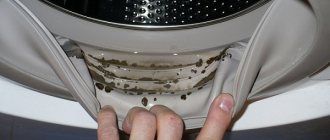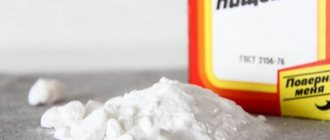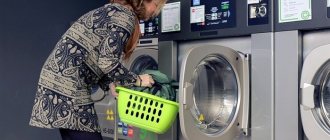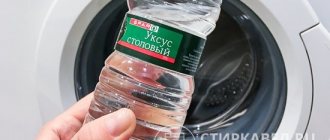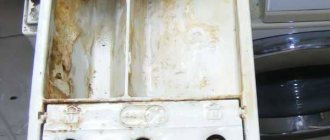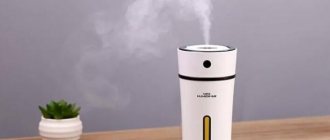The rate of sediment formation is affected by the intensity of use, frequency of washing at high temperatures, and water hardness.
High-quality regular cleaning helps to cope with the problem. To learn how to remove scale from an automatic washing machine at home, read the article.
Causes of unpleasant odor
If you are reading this article, then the topic is relevant to you, which means that one fine day you suddenly discovered that your washing machine is emitting, to put it mildly, an unpleasant odor. At best, it will simply be a damp smell, which is often found in basements. In a more advanced version, it will be a pronounced sewer smell. And then bewilderment sets in, especially if your machine is completely new or you did everything as always. The usual smell of freshness can be replaced by a foreign aroma for several reasons :
- The most common and most basic mistake is closing the hatch immediately after removing the washed items. This is strictly forbidden. The moisture in the drum dries out within a few hours. Only after this time has passed can the lid be closed to prevent it from sagging in the future. Otherwise, you will create more than favorable conditions for the proliferation of various microorganisms or mold - the drum will be warm and damp. Believe me, when in a couple of days you open the hatch, you will simply be horrified, because your device has simply “choked.” And if you wash things without first eliminating the smell, they will also acquire a characteristic aroma;
- Even if some housewives are not lazy and still wipe the drum dry after washing, not all of them pay attention to such a detail as the elastic band along the contour of the hatch . It has a rather complex shape, on which the tightness depends. There are several layers, between which, in addition to water and detergent residues, threads, lint, hair and other objects can remain. In conditions of high humidity, this material is an excellent place for mold to form, which will eventually emit a strange odor. Sometimes it is not even immediately possible to understand why an extraneous odor is present at all if the drum is dry and clean. Therefore, it is better to leave the drum to dry naturally, but carefully wipe the elastic band with a dry soft cloth;
- Another mistake that occurs almost everywhere is storing items to be washed in a drum. And if you close the door at the same time... Remember, dirty things will in any case have a characteristic odor, which will very easily and persistently attach itself inside the drum. Especially if you also block the air supply to things. It’s not for nothing that laundry baskets were invented. They are even produced in different sizes, shapes, colors and designs. Everything so that you can harmoniously fit this attribute into the interior of the bathroom and use it for its intended purpose. All baskets have holes in the walls, lid and bottom, thereby providing ventilation;
- Another reason could be improper installation of the machine . Please note, not connection, but installation. If the appliance is tilted, this may prevent the water from draining completely. As a result, in the corner where there is the smallest slope angle, a small amount of water will remain and stagnate. When exactly musty water makes itself known is only a matter of time;
- If the machine is quite old, the cause of the unpleasant odor may be a clogged drain hose. If a smell appears, it means that so much debris has already accumulated on its walls, on which soap scum, salt, etc. have settled, that it will be much easier and more expedient to replace it than to clean it;
- If you overuse laundry detergent and various conditioners, this can also contribute to the appearance of characteristic odors. Excess product, which simply did not have time to dissolve during washing, sticks to the walls of the machine, the tray for pouring powder, and after some time begins to “smell” actively. And not at all a pleasant aroma of fragrances, as you would like, but rather something rotten. In this case, the rule “more is better” does not work at all. A lack of washing powder will simply result in things not being washed. Therefore, it is best to purchase a measuring spoon or cup and pour in exactly as much powder as the manufacturer recommends in the instructions on the package;
- You should also pay attention to the quality of the products used in washing. Frankly cheap powders may not dissolve well in water. The result will be similar to the point above. Therefore, whenever possible, purchase quality products. In addition, their consumption will be much less, and the washing result will be of higher quality;
- If the tray for loading powder and conditioner is dirty, this can also cause the formation of various odors;
- If the tray is very dirty, then contamination of the channel that is responsible for supplying the detergent is automatically inevitable. Because of this, mold may form, which will smell;
- Another problem area is the drain filter . It is designed to hold various large objects, for example, buttons, pennies, so that they do not clog the sewer. Remaining on the filter, such things gradually begin to become overgrown with soap deposits, to which all sorts of lint strings stick, silt up and begin to stink. It is quite easy to understand whether this is the reason. If the filter is clogged, the water will drain very slowly or stop draining at all;
- If the smell is similar to something rotten or rotten, it means that an impressive layer of dirt has formed on the heating element. If the heating element has scale layer, undissolved detergent particles settle on it very quickly, hair, threads, pet lint or woolen items stick to them. Such a “cocktail” especially makes itself felt if the most familiar washing mode for you is at a temperature of 30-40°C;
- Problems with the sewerage system itself cannot be ruled out. But then, in the event of any accidents or breakdowns, an unpleasant odor will come from both the sink and the bathtub. And if the aroma comes only from the washing machine, perhaps it is not connected correctly - there is no air or water barrier.
As you can see, there are a lot of reasons. Often they are present in a complex. Therefore, the very first step towards identifying the source of the unpleasant odor will be a complete inspection of all elements of the washing machine.
Cleaning out the trash can
The first thing you need to do is clean the garbage filter. Most often, the “trash bin” is located in the front lower right corner of the case. As a rule, the nozzle is hidden behind a decorative door of a rectangular or round shape. Getting to the drainage is not difficult, just follow the instructions:
- tilt the body of the machine back so that the front legs rise into the air by 5-7 cm;
- We place a small container under the technical hatch to collect water;
- use a screwdriver to pry up the hatch, unfasten the plastic latches and remove the door;
- inspect the filter, black or blue plug, and emergency drain hose, orange or red;
- pull the hose and drain the water into a substitute basin;
- if there is no drain hose, then unscrew the garbage filter counterclockwise to get rid of the water;
It is forbidden to empty the machine through the garbage filter immediately after the end of the high-temperature cycle - the water will not have time to cool down and will burn!
- unscrew the “trash can” all the way;
- assess the condition of the seat and the filter itself;
- We clean the nozzle from debris and scale.
A heavily soiled filter will have to be soaked in a warm lemon solution. The clean nozzle is screwed into place, and the machine returns to its original position.
Why does the machine smell like burning?
Sometimes a washing machine can smell not only of dampness, mustiness or rot, but also of burning. This can happen in several cases:
- If the washing machine has just been purchased. Usually, when you first start it, a slight smell, reminiscent of a burning smell, is normal. But it is worth emphasizing that it is light and short-lived. It may appear when plastic parts are heated. And after the second or third turn on it should disappear completely;
- An old machine may also smell like burning, but this is only normal if you replaced the powder with a new one, and it turned out to be not of very high quality, or if shavings of laundry soap were added directly to the drum during washing. This is especially often done by mothers of newborns, arguing that it is safer for the child. There is no point in arguing with this. The smell appears if soap particles get on the heating element and stick to it. In this case, it will emit burning not just during washing, but during the subsequent start-up while heating the soap residues.
If none of the above options are typical for you, or the burning smell does not disappear after running the machine at maximum temperature without idling, be sure to call a technician , because most likely we are talking about the breakdown and melting of some contacts, which can lead to a short circuit.
Location of the element in the Bosch washing machine
On traditional horizontal-loading machines, the cleaning elements are in most cases located on the front panel. Older models do not provide any plugs, so the component protrudes slightly. For new devices, such a cover has already become commonplace.
Lid opening options:
On the bottom of the front panel there is a special strip that occupies the entire edge. This cover is secured with latches, the opening of which will allow the user to gain direct access to the washing machine filter.- On the right there is a small rectangular lid that can be opened with a knife or screwdriver.
- The round hatch closes the element or opens it with a light touch.
Horizontal loading washing machines are also equipped with filters. Most often, it is located in the front part of the case behind a small rectangular or round cover. At the same time, the removal of the component and subsequent cleaning is not much different from a similar process on machines with horizontal loading.
Models of washing machines produced before 2005 did not have drain filters. So it will be useless to look for any cover.
On such devices, the volute could sometimes become clogged , which cannot be cleaned without separating the pan and disconnecting the pipes.
How is scale formed and why is it dangerous?
Another inevitable problem when operating any device that comes into contact with water is the formation of scale. If you have a boiler with an open or “wet” heating element, then you probably know this phenomenon.
Scale is hard deposits that form on the surfaces of elements that come into direct contact with water and heat it. reasons for the formation of such plaque:
- The most basic is the very poor quality of water, which contains many different impurities and components. In some regions or areas the water may be softer, in others it may be too hard. The water contains magnesium and calcium salts, which are the most harmful to the heating element and the washing machine tank. When water is heated, the salts of these minerals precipitate and form solid deposits;
- In addition to impurities in the water itself, various chemical additives in washing powders also have a detrimental effect;
- Also, scale forms very quickly when the machine is regularly used in the “intensive wash” mode.
to get rid of scale . And it is best to use them in combination. But first of all, you need to evaluate how advisable it is to do this right now. To do this, you need to try to consider the state of the heating element through the holes of the drum. To do this, you need to shine light into the holes and rotate the drum. You will understand in the process how best to do this quickly. If characteristic deposits are visible on the surface, perform two types of cleaning in sequence:
- Mechanical. It is a very effective way. But to do this, you will need to thoroughly study the structure of your device and be able to disassemble it without dire consequences. After you get to the heating element and more clearly appreciate the full scale of the tragedy, you will need to remove the hard coating. It is highly not recommended to use knives, screwdrivers, files and other improvised tools for these purposes that can leave scratches on the surface. It is better to use a sponge with a hard layer, fine-grained sandpaper;
- After this, to remove any remaining scale, soak the heating element in a solution of vinegar or citric acid for several hours, then thoroughly brush with a toothbrush and rinse with clean water. Also, with the help of these two products, you can clean the machine without disassembling it, but more on that a little later. I would also like to clarify exactly what is dangerous about excessive scale accumulation on the heating element:
- The level of heat transfer from the tubes, which are called heating elements, is noticeably reduced due to the build-up of plaque on their surface. This causes the water to heat up more slowly;
- As a result, to achieve the set temperature, the machine needs to work much longer, which naturally entails increased energy consumption;
- The large load that falls on the heating element under such operating conditions will lead to its rapid breakdown and the need for replacement;
- And as we have already found out, scale formation can cause an unpleasant odor.
- An excellent method of preventing scale formation is to install a magnetic filter. This small device is attached to the water supply hose and creates a constant magnetic field. When the machine is filled with water, passing through the formed field, it changes its structure. As a result, impurities are destroyed and do not settle on internal surfaces. The cost of such a device is quite high, however, its service life reaches 50 years, which fully justifies the costs.
Preventing blockages
The following preventive measures will help prevent blockages:
- Do not allow foreign objects to enter the drum. All pockets must be checked in advance, loose buttons must be sewn on, etc.
- Washing items stained with technical oils is not advisable, since substances partially washed off from the fabric are deposited on the components of the washing machine.
- Washing items with long, loose pile and a lot of pilling can lead to clogs.
- For washing in an automatic machine, you must choose only those detergents that are intended for this purpose. Using regular soap shavings, for example, can cause detergent to stick and cause a clog.
- From time to time, at least once a week, washing should be done at a high temperature of 60°C.
- Using water softeners will prevent the formation of strong limescale in hard tap water.
- It is advisable to clean with vinegar or citric acid once every 2-3 months.
- The drum should not be used as a place to store dirty items. Laundry baskets are suitable for these purposes.
- Already washed clothes should not be kept in the drum for a long time.
Method 1. Cleaning the washing machine with soda
Before resorting to various types of household chemicals, we suggest trying to eliminate the unpleasant odor associated with the formation of mold using regular baking soda.
- First of all, you need to find where the mold is forming. Perhaps this is the surface of the drum itself, the tray for loading powder, or the surface of the rubber seal;
- First, let's prepare a soda-based paste. To do this, mix 0.5 cups of soda and 0.5 cups of water.
- Mix thoroughly until a paste-like consistency is formed;
- Be sure to wear rubber gloves;
- Apply a little paste to a sponge and rub the affected surface well;
- After this, you need to rinse off the paste and turn on the machine to rinse mode.
Using a mixture of baking soda and citric acid, you can try to remove scale from the internal surfaces of the machine. For this:
- Mix 150 g of citric acid and 2-4 teaspoons of baking soda;
- The mixture must be poured into the tray for loading washing powder;
- Turn on the machine to wash mode at the highest temperature, and after finishing, run an additional rinse cycle.
- Naturally, you need to pour any machine cleaning product into a pre-washed tray. Also note that the drum must be empty. If for some reason you don’t like the machine to run idle, throw in a floor rag or an old towel. In general, something that you wouldn’t mind throwing away if the color changes.
Preparatory activities
Once the user has been able to detect the filter on the body of the washing machine, it is recommended to take a number of additional measures aimed at ensuring the safety and convenience of the cleaning procedure.
First of all, you must immediately turn off the power supply and shut off the water supply . After this, you need to tilt the car back a little and place a basin under the lower part of the body, and also stock up on rags to remove water.
Even if the machine is idle for a long time, a certain amount of water still remains inside the machine, which can easily flow out through the hole.
Method 2. Wash the machine with citric acid
Using citric acid you can also eliminate the unpleasant odor associated with the formation of scale. The secret is that expensive products that are designed to remove plaque are almost 75% acid. So why pay more?
- Pour 50-100 g of lemon into the powder loading tray;
- Select the longest wash cycle at the highest temperature;
- After finishing washing, run an additional rinse.
I came across a large number of reviews on various forums that said that after cleaning the machine with citric acid, the smell not only did not go away, but also intensified. I'll explain why this happens:
- Apparently, your machine is more than one year old and during its operation a large amount of scale and various contaminants have managed to settle on the surface of its heating element;
- Plus, most likely, in order to reduce washing time and save energy, you most often washed at temperatures no more than 40°C;
- After you ran your machine, firstly, at maximum temperature, and, secondly, with the addition of acid, which breaks down scale and other sediment, they simply could not dissolve completely;
- After you turn on the machine again after a few days, as the water heats up, the remaining scale and dirt also heats up and begins to re-emit an unpleasant odor.
- Therefore, you simply did not clean the machine. Just repeat the procedure and see how the smell disappears completely. You need to use citric acid, and not lemon juice, the concentration of which is much lower.
Despite all the advantages and effectiveness of this method, it is highly not recommended to use it more than once every 6 months and use more acid. There are many diametrically opposed opinions expressed online regarding this method of cleaning a washing machine, from 100% favorable to completely negative. It is likely that such a radical difference in the opinions of readers is associated with the operation of equipment from different manufacturers, produced in different time periods using different materials.
Tips and tricks
- It is important to regularly remove plaque, as it makes it difficult for the drum to rotate and can lead to its failure;
- A clean heating element (heating element) will reduce electricity consumption , as it will heat water more efficiently;
- Using special products for washing water to soften , for example, Calgon, will not bring the desired effect - their active ingredient, sodium tripolyphosphate, is not able to remove salt deposits, but can lead to the formation of plaque due to excessive softness of the water;
- The use of acids should not be carried out more than 2 times a year - this can lead to damage to the device.
Method 3. Vinegar as a preventative measure
Using regular 9% vinegar, you can get rid of such troubles as fungus or mold .
- The tray for loading washing powder should also have a compartment for pouring liquid powder. This is where you need to pour 2 cups of vinegar;
- Select a high temperature wash program and start the machine;
- After the machine has worked for 10-15 minutes, you need to press pause and leave it in this state for an hour or two;
- This is necessary so that the vinegar solution has time to have the proper effect on microorganisms and, possibly, dissolve a thin layer of scale;
- After this, resume washing and let the “wash” mode finish;
- An additional rinse completes the cleaning;
- After this, open the machine, take a clean cloth soaked in a vinegar solution, and thoroughly wipe the rubber seal and inspect it for debris;
- Leave the door open to dry the drum and wipe the rubber with a dry cloth.
Keep in mind that cleaning with vinegar is accompanied by a characteristic odor.
By the way, some housewives add vinegar directly during washing. Literally 1-2 tablespoons. It acts as a water softener, thereby preventing scale formation. And if you add apple cider vinegar, the laundry itself will acquire a barely noticeable, light and pleasant aroma.
Prevention
The main points that should be adhered to in order to maintain the original appearance and functionality of the automatic machine:
- Pour/pour in the amount of powder/conditioner specified by the manufacturer, no more. If you use more detergent than needed, your clothes will not get cleaner. While the excess funds will settle in the car.
- Be sure to take change out of your pockets.
- Do not leave dirty or freshly washed items in the drum for a long time.
- Try to leave the door open to avoid creating favorable conditions inside for mold to grow.
Method 4. Chlorine for cleaning a washing machine
Also in the vast expanses of boarding schools you can find many conflicting reviews about whether chlorine can be used as a cleaner, does it corrode rubber elements? It's possible, if you don't abuse it. fight mold and disinfect hard-to-reach places in your washing machine using regular whitewash:
- Pour 100 ml of white into the drum;
- Turn on the wash cycle at high temperature;
- It will take about 30-40 minutes to destroy microorganisms;
- After this, turn on an additional rinse.
It is recommended to clean with a chlorine-containing product no more than once every 6 months. Also be careful when using Domestos instead of white. Keep in mind that it tends to foam.
Checking the functionality of household appliances
After cleaning the drain filter has been carried out, you need to ensure the quality of the work performed. To do this, the Bosch machine is connected to communications and the wash cycle is started. When starting up for the first time after cleaning the filter, you must be near the operating device to monitor its operation.
After cleaning, if the part was not put back into place carefully, water may leak from the unit. To solve the problem, the panel behind which the filter is located must be removed and the assembly checked for correct and reliable installation. If cracks or other damage to the filter plastic are found, the part will have to be replaced.
If cleaning the filter was carried out as part of the fight against a problematic drain, then the cleaning work performed is not always able to solve the problem. In the event that the drainage does not improve, it will be necessary to use alternative methods to resolve the issue .
Method 5. The best ready-made remedies
If folk remedies do not inspire confidence in you, at any household chemical store, you can purchase a ready-made product either for disinfection or for removing scale. The most effective of them:
- Detergent for German washing machines. It is produced in the form of a liquid, which, according to consumers, is very effective and helps to dissolve even an impressively thick layer of scale;
- Another German liquid product, Topperr 3004, is sold in 250 ml bottles and is designed for two cleanings;
- A universal product that is intended for cleaning not only washing machines, but also electric kettles, irons, dishwashers and other household appliances, “Luxus Professional”. It has a lemon scent and is sold in 500 ml bottles. There is enough liquid for 4 full cleanings;
- The concentrated Korean remedy is available in powder form. There are only 4 sachets in the package, respectively, for 4 cleanings. Before use, the powder is dissolved in water, the amount of which is indicated on the package;
- The Japanese product “Kaneyo” is also in demand. It not only removes scale, but also has an antibacterial effect. Sold in bottles and containing chlorine.
Professional products
We also advise you to use the following products to combat scale inside the washing machine, which you will see in the photo:
"Antinakipin"
Five Plus
Dr. Beckmann
AntiKal
Frau Schmidt
Remedy from "Electrolux"
- "Antiscale";
- Five Plus;
- Filtero;
- Beckmann;
- AntiKal;
- Descaler;
- Frau Schmidt;
- line of cleaning products from Candy, Electrolux, Bosch, etc.
Method 6. Clean individual elements of the washing machine
We've told you exactly what means you can use to clean your machine, now we'll tell you how to get to the most problematic areas. To remove and thoroughly wash powder loading tray
- Understand how the tray is attached. It is usually held in place by side latches. Most often, it is enough to press the latches and pull the compartment towards you, lifting it up a little. Some models have a button on the side that must be held to release the fastenings;
- When you have the compartment in your hands, first rinse it well under hot water;
- Using a toothbrush, carefully remove any remaining detergent from all possible grooves;
- If the plaque is very persistent and there are traces of mold, use a solution of citric acid, soda or bleach;
- Also inspect the place where the tray is inserted, perhaps there are powder residues there too.
The problem area, where all sorts of debris most often accumulates and mold forms, is the rubber seal along the contour of the hatch.
- It is most convenient to wash it immediately after washing, when it is still damp;
- For convenience, stock up on ear sticks or tissue;
- The fabric must be wrapped around your finger and carefully reached into all the folds;
- For cleaning, use vinegar, which will not only help get rid of microorganisms, but also eliminate the odor. You can also use a solution of bleach and water in a 1:1 ratio;
After you have used one of the descaling methods, it is very likely that some scale particles remain in the drain filter . And not only them, but also all sorts of small objects that can fall into the machine if you do not check the contents of the pockets before washing. To clean it you need:
- Find where the filter itself is located. Usually there is a plastic cover or plug on the front of the machine body, in the lower right or left corner;
- It must be carefully picked out and removed;
- Be prepared for the fact that after removing the lid, residual water may leak out - spread a rag;
- If the water no longer flows, you can pull out the plug;
- All debris must be removed and the filter rinsed under running water. Use detergents if necessary.
the drain hose should also be cleaned , but if this was not enough, you will have to clean it separately:
- Unplug the washing machine and turn off the water supply;
- Place a low container under the hose attachment point, then unscrew it;
- Inspect the interior surface. If everything looks scary, try cleaning the cavity with a cable with a soft brush attached to the end;
- If cleaning does not produce results, it is better to replace the hose with a new one.
Let's get busy with the pump
Getting to the pump is more difficult - you will have to partially disassemble the machine and the pump itself. To begin with, the washing machine is disconnected from the power supply, water supply and sewerage, and then moved away from the wall. Then the algorithm is as follows:
- remove the powder receptacle;
- Unscrew the two screws hidden behind the tray;
- loosen the bolts around the perimeter of the dashboard and disconnect the board from the body (there is no need to completely disconnect the module, just hang it on the side or put it on top);
- pry open the technical hatch door and move it to the side;
- remove the outer clamp from the cuff and tuck the elastic inside the drum (there is no need to completely tighten the seal - it is very difficult to put it back);
- disable UBL;
- unhook the front panel from the washing machine;
- drain the water from the machine.
Now we find the drain pump at the bottom of the structure, unscrew the bolts holding it, disconnect the wiring and, swinging, remove it from the machine. Afterwards, we begin cleaning: we free the impeller from hair and threads, clean off dirt from the surface of the drainage and the nearby cochlea. Next, we disassemble the part and wash the internal elements.
The cleaned pump is reassembled and returned to its place, securely fixed to the volute. If during installation it is noticed that the impeller is dangling or flying off the shaft, then you should not try to secure it with sealant or glue . It is safer to replace the pump completely.
Method 7. How to clean a top-loading machine?
Top-loading machines are more difficult to maintain; they have more hard-to-reach places, so we will clean them using various compounds:
- We need a wash cycle at the highest temperature;
- Add 2-3 cups of vinegar to the water, after a few minutes add another 0.5 cup of baking soda.
- The reaction will begin;
- Stop the machine and leave for 0.5-1 hour with the solution inside;
- At this time, using a vinegar solution, thoroughly wash the powder loading tray and the outside of the machine;
- Resume the washing process. Once completed, drain the water and look inside. If there is dirt, remove it with a sponge.
The article was written for the site.
Tags:Bathroom, Cleaning
How to wash
To ensure that your washing machine does not break down due to frequent use, you need to constantly keep it clean.
IMPORTANT! Keeping it clean means regular general cleaning (the entire device must be cleaned, from the outer case to the internal elements).
Drum
The best place to start when cleaning is the drum. It is in it that after each wash the remains of dirty liquid, fat deposits, plaque particles, etc. remain. In addition, black spots may appear in the folds of the rubber cuff, indicating the appearance of mold. And the musty smell coming from the depths of the machine also does not make its use pleasant.
Drum cleaning:
- The easiest way to solve the problem is with an unpleasant odor. To do this, you need to run the machine in idle mode and add citric acid or suitable disinfectant compounds inside.
- Next, you should move on to cleaning the rubber seal. You'll have to clean it by hand, so be prepared. To begin, spread the folds apart, and then wash the entire circumference of the cuff using a clean dishwashing sponge soaked in warm soapy water. Do everything carefully so as not to tear the seal.
- At the end, you need to wipe the gum DRY, since stagnant moisture can again lead to the appearance of plaque and odor .
- If you see that mold spots have appeared on the cuff, then you need to prepare a solution of copper sulfate or baking soda paste (water and baking soda powder mixed in equal parts). One of the two indicated preparations should be used to treat the areas affected by mold and leave the product for a couple of hours.
- Wipe everything thoroughly with a sponge and run the machine in long-term wash mode.
Read more about how to clean the drum of a washing machine in the article.
heating element
IMPORTANT! The heating element is the most important element of the washing machine, which, if not properly maintained, can fail at the most inopportune moment.
The tubular electric heater is in direct contact with running water, and therefore, after each use of the washing machine, scale will accumulate on it (it is salt deposits of magnesium and calcium).
If you do not have a water softening filter in your drain, then when washing you should also add special water softening agents to the washing powder (for example, the much-advertised Calgon). It is also worth doing monthly maintenance to avoid breakdowns.
Method number 1:
- The easiest way to deal with lime deposits is with tribasic carboxylic acid or regular citric acid. Pour the acid into the powder tray, and then turn on the washing machine in any high-temperature wash cycle. The acid will corrode plaque and limestone and clean the heating element and drum steel from scale.
- Calculate the amount of acid powder based on the degree of contamination of the machine, as well as its capacity. Typically, for every kilogram of filler there should be 25-30 g of acid.
- If you haven’t cleaned the machine for a long time, then you can do the following trick: pour the acid powder into the powder tray, turn on the machine for a long wash cycle at 90 degrees, and then turn off the unit from the network in the middle of the process. Leave the device overnight and run the wash again in the morning.
- This experiment should be carried out no more than 4 times a year. After each such procedure, you need to inspect the drain hose and cuff; large particles of limescale may accumulate there; they will need to be removed manually.
Method number 2:
- It is best to use specialized preparations for cleaning. They have one significant advantage over all folk remedies combined - they are developed taking into account the design features of the unit, and therefore their composition will never harm any element during cleaning.
- Remember that most products can protect the machine from the appearance of plaque, but they do not guarantee getting rid of existing scale . Most often, such products simply soften the water, which significantly reduces the amount of salts in it (for example, like Calgon).
- These products should be used during washing. Simply add them to the powder tray (along with the powder) or directly into the drum, and then start the wash.
WE RECOMMEND! Read on our website detailed instructions on how to clean a vacuum cleaner at home.
Rubber compressor
So, you have started the machine in self-cleaning mode at the drum cleaning stage. When the procedure is completed, you can begin cleaning the rubber seal.
A rubber seal is an ideal zone for the growth of various fungi, mold and other microorganisms that harm humans and the device itself:
- You can clean the cuff using almost any cleaning product. For example, you can use Pemolux or baking soda (if you prefer folk remedies).
- If there is too much mold, and even an unpleasant odor is added to all the existing contaminants, then it is better to choose Komet, White (as a last resort), Domestos or Utenok. These tools are much more powerful. They can not only clean the gum from pockets of mold, but also disinfect it.
- Apply a small amount of the desired cleaning agent to a damp sponge or rag (if you are working with bleach, do not forget about gloves and safety glasses), then pull the cuff towards you and wash the metal elements of the case.
- In the same way, run the cleaning agent over the elastic itself.
- Since most of the dirt remains at the bottom of the hatch, its entire circumference should be cleaned.
- After all procedures, go over the cuff with a damp, clean cloth.
Read detailed instructions on how to clean elastic in the washing machine.
Drain pump
After cleaning the drum, cuff and heating element, you can proceed to cleaning the drain pump (drain filter). If you have already seriously neglected the condition of this element, then do not be surprised when one fine day the machine simply stops draining water through it.
In order to avoid a flood, you need to regularly clean the pump from dirt and lime deposits :
- You need to take a container of suitable height (for example, a baking tray from the oven), a towel or a well-absorbent rag, a flat screwdriver or any other flat tool.
- Now open access to the filter (most often the entrance is located at the bottom of the machine). Before unscrewing the lid, cover the floor with a towel or rag, and place a container under the drain to collect water (just in case of a fire).
- Unscrew the filter cap counterclockwise and remove all debris and accumulated dirt from the pump.
- Next, wipe the hole with a clean damp cloth, close it and install the panel in its rightful place.
Water inlet filter
In addition to the drain filter, the washing machine also has a water inlet filter. It also becomes covered with rust and sand over time. When the inlet hose filter becomes unusable, the machine refuses to wash and shows that it is impossible to draw clean water.
How to clean the filter:
- First, you need to shut off the access of cold water to the washing machine.
- Next, turn the machine around to see access to its rear panel. On the right, in the upper half of the housing, you will see the inlet hose.
- Unscrew the nut counterclockwise and look inside the opened hole. Did you see a small filter with a mesh? This is exactly what you have to get out with the help of pliers or pliers.
- Using a toothbrush, rinse the filter under running water, then return it to its place and screw the inlet hose back clockwise.
- Run cold water.
Powder tray
ADVICE! Ideally, the tray for powder and other laundry preparations should be washed after each use of the washing machine. This will help prevent the remnants of powders, gels and other products from accumulating in the grooves and leaving an unpleasant odor and residue on the surface.
If you do not regularly clean the tray of powder, you will have to work hard to clean everything at once. You will have a hard time, because the container has many small grooves and other hard-to-reach elements that are difficult to get to with a regular rag or sponge:
- To begin with, you can thoroughly spray the compartment with a spray cleaner and leave it to soak for a couple of hours.
- Next, you can start cleaning the tray itself, which is covered with rust, plaque and residues of cleaning products. You can use household chemicals for this (like Pemolux) or folk remedies (a mixture of soda, hot water and vinegar).
- Treat the container with the chosen product and leave it to soak for another half hour.
- After this, go over the container with a sponge or toothbrush, removing any remaining cleaning products.
- Wipe the tray dry and place it in its usual place.
Why do you need to clean the washing machine drum?
The drum, when dealing with dirty laundry, becomes dirty over time. In washing machines without automatic cleaning, you have to do it yourself. To do this, pour bleach, vinegar, citric acid into the machine, add soda or other cleaning and disinfectants.
Thanks to treatment with cleaning agents, the drum gets rid of dirt, bacteria, mold, scale, unpleasant odors and soap deposits. If you don’t clean the “inside” of the machine in time, a putrid smell will emanate from it, and washed items will also smell like it.
If you neglect the cleanliness of the SMA, it will fail prematurely. If you bought a model with Eco, you don’t have to use special cleaning products or run the washing machine empty - the device will take care of its cleanliness.
More: Description and characteristics of Bosch Maxx 5 Speed Edition
Advice from experienced housewives - a selection of the best folk methods for solving the problem
Almost all effective cleaning products that are used to remove scale contain some kind of acid. It is this that combines with salts dissolved in water and then reacts with them. This is how descaling occurs.
Experienced housewives use these store-bought products to treat their washing machine.
We list the most popular cleaning methods:
- Citric acid is placed in a container intended for detergent. You need to take 100 grams of lemon powder. After this, select the longest laundry program. It is important that the water temperature is not lower than 60°C.
- In the evening, citric acid is poured into the detergent tray. Then a wash cycle with a temperature of at least 90°C is selected. In the very middle of the process, the washing machine must be stopped by cutting off its access to electricity. The machine, disconnected from the network, should remain in this state until the morning. This time will be enough to clean the drum and ten. In the morning, the washing machine connects to the network again and continues to work from the moment it was stopped.
- You need to add white to the citric acid and run the longest wash cycle. The water temperature must be at least 90°C. Please note that when choosing this method of cleansing, you need to take care of ventilation. Good ventilation should be not only in the room where the unit is installed, but in all rooms. It is advisable that there are no people in the apartment. Chlorine fumes can cause health damage. They also negatively affect human mucous membranes.
- Acetic acid is used to clean the machine from scale and dirt. You need to pour 50 to 100 ml of vinegar into the detergent tray. Then select the longest streak mode. The water temperature must be at least 60°C. This method is very effective, but it is also considered aggressive. To achieve the best result, the operation of the machine is interrupted for one hour, then the cycle should continue again.
Expert opinion
Borodina Galina Valerievna
Cleaning parts from scale should be carried out no more than once a month.
During the treatment of the machine with citric acid, its rubber parts are gradually destroyed. What other cleaning methods can be used:
- Fungus and mold on the drum can be easily removed with a soda solution. Ratio: 250 grams of soda are diluted in 250 ml of water. The resulting solution is used to treat the inner surface of the drum.
- Chlorine-containing products help fight mold spores. You can use bleach or any other bleaching agents. 100 ml of white should be poured into the drum and run an idle wash for 30 minutes. The water temperature must be at least 90°C. It is better to leave the apartment at this time, leaving the windows open.
- Another rather unconventional method. In 100 grams of warm water you need to dilute 50 grams of copper sulfate. Mix the resulting mixture well, then pour it into the drum. Select a wash cycle with a temperature of 90°C and start it. 30 minutes will be enough for cleaning.
The cleaning procedure for washing machine parts is carried out only in the “idle” wash mode. In this case, there is no need to put laundry in the drum!
Do you clean your washing machine?
Of course! No, but I will!
